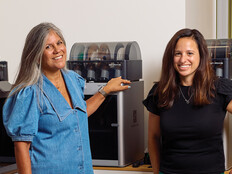Product Review: Sizing Up the ASUS Eee PC Mini-Notebook
A large screen and keyboard make the latest ASUS Eee easy to operate.
The idea behind Mini-notebooks pleases the techie in me.
When I saw the first 7-inch model of the ASUS Eee PC, I thought it was a great concept, but the keyboard was too small for my hands. ASUS has since released the 1000 series, which includes 10-inch screens, larger keyboards and more processing power. They’ve got the right size this time.
Advantages
When unpacking the Eee, I was impressed with the way ASUS packaged the little notebook. It might seem strange to mention packaging, but anyone who has removed a notebook from a crushed box understands.
Inside the box was the usual “Getting Started” poster and a power brick. A nice addition is a microfiber cloth for cleaning the shell and the screen, something that would be welcome with all new notebooks. The power connector is on the right side of the machine and includes a thoughtful 90-degree design. (This will help if you are buying a lab’s worth of these to use from a cart.) Also included are three USB ports, a VGA connector, an Ethernet jack and an SD card reader.
The model that I evaluated came equipped with a 1.6 gigahertz Intel Atom processor, 1 gigabyte of RAM, a 40GB solid-state hard drive and Linux (rather than Microsoft Windows). The Linux system boots fast, and everything I launched ran fast as well. But any program that requires substantial computing power will suffer because of the processor. For example, I loaded Windows XP during testing and noticed it took nearly 90 minutes to load Service Pack 3 on top of the WinXP SP2 install. I didn’t run into these issues while using Linux, and I suspect that it has to do with its specially tuned version of Xandros Linux.
The mini came bundled with several open-source titles, as well as Sun Microsystems StarOffice. I ran into some issues with StarOffice and ended up replacing it with a more current version of OpenOffice, which made the notebook more reliable. The Eee is clearly geared toward the education market and came with educational software and games.
Why it Works for IT
I normally take a notebook to meetings so I can access my calendar — as well as files, the web and e-mail. I decided to tote along the Eee rather than my regular system. Technology personnel will appreciate the built-in Remote Desktop program that allows access to Windows servers wherever you can find a connection.
When booting, the notebook presents a desktop with all icons arranged in folders — a bit different from the familiar launch or Start menu. I found the desktop easy to navigate for preloaded programs but could not figure out how to add programs to the screen. This was frustrating, but I quickly found some programs on the web to run the K Desktop Environment instead of the Eee desktop, turning this into a quite powerful netbook.
Battery life is also impressive at up to six hours, and standby/hibernate extends life significantly.
Disadvantages
Although I was pleased with the customized Xandros Linux, it needs some tweaks to accommodate a power user. In a school environment, the standard configuration should be fine.
The keyboard was far more usable than that on the 7-inch Eee, but I still ran into issues with the right-hand Shift key because of its placement. It took a conscious effort to hit that key rather than the up arrow key — many times I found myself typing one line higher than where I wanted to be.







